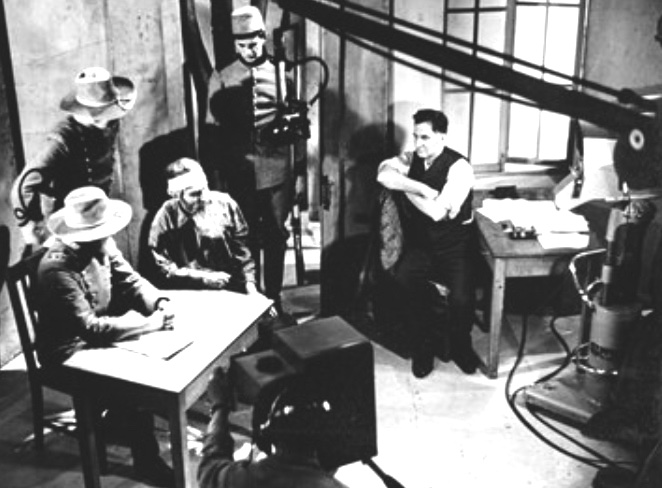OTD in early British television: 17 July 1939

John Wyver writes: The evening of Monday 17 July 1939 saw one of the BBC’s two mobile control rooms back at the Victoria Palace Theatre for a reprise OB of the musical Me and My Girl, first broadcast on 1 May and subject of an earlier blog post. The transmission came at the end of a week in which there had been a major drama each day, indicating how ambitious the Alexandra Palace schedule now was.
Tuesday 11 saw the second playing of a studio staging of Michael Barringer’s mystery play Inquest which had premiered at the Windmill Theatre in 1931. This had been made into a film in the year it was first played, and it appeared again as an hour long ‘quota quickie’ movie, this time directed by Roy Boulting, in December 1939. At AP an 80-minute adaptation, produced by Lanham Titchener, had former silent movie star Mary Glynne and Herbert Lom as the leads, and Lom again took the role of the Coroner in Boulting’s film.
The afternoon of Wednesday 12 brought a presentation by Jan Bussell of Ronald Gow‘s 1933 historical drama Gallows Glorious (pictured), a tale set in the United States in 1859 with Neil Porter as abolitionist John Brown.
The following day, Thursday 13, saw not only the OB from the Garrick Theatre of The Desert Song in the evening, but also an afternoon offering overseen by Eric Fawcett of Lynton Hudson‘s comedy Luck of the Devil, adapted from the French original by Jean de Létraz. This was drawn from Leonard Sachs‘s production at the Players’ Theatre in Covent Garden, and included Jack Melford and Megs Jenkins in the cast.
Friday 14 brought the second playing of Fred O’Donovan’s production of The Fame of Grace Darling to the studio, and on the evening of Saturday 15 Michael Barry mounted Somerset Maugham’s tale of a barber who wins a sweepstake, Sheppey. In his memoir From the Palace to the Grove, Barry describes this as an ‘allusory play about the meaning of charity’. Aubrey Mather took the title role.
Finally, the Sunday play on 16 July was Irish writer Rutherford Mayne’s Bridge-Head, based on Michael Macowan’s London Mask Theatre production that had recently been at the Westminster Theatre. This tale of the work and impact of the 1881 Land Commission in rural Ireland was overseen in the studio by Dallas Bower.
Bridge-Head was soon on the receiving end of one of Grace Wyndham Goldie’s harsher responses:
The fact is that television has reached a new stage. As the old crudities are left behind a whole set of fresh problems is revealed. And the most pressing is that of directing the attention of the viewer to whatever is significant in the television picture. When this is done successfully, the screen seems right size; the story grips attention; the characters become human; we can appreciate the qualities of the acting.
When the producer fails, as in Bridge-Head, the general effect is grey ; there is no impact of personality ; the actors act away like anything without making the smallest effect and the whole performance, taking on a curiously unreal air, sinks back into the screen instead of standing away from it.
The problem, then, is important enough. And it has, obviously, two parts. The first is that the producer should firmly make up his mind what he wishes to emphasise; and the second is that he should have sufficient control over the physical means of production, casting, lighting, setting, grouping, camera work and so on, to be sure that the emphasis is passed on, with equal firmness, to the viewer.
It was impossible to guess in which of these ways the producer of’ Bridge Head’ failed. For no emphasis of any kind was apparent; nothing was in relief and the level plain of the action was as featureless as a desert.
This unforgiving critical response aside, the week’s schedule is still a remarkable output for a single, and far from atypical, week not yet three years into the operation of Alexandra Palace. The two small studios, overworked creatives and technicians, and minimal other resources were offering a remarkably rich dramatic menu, as well as variety, talks and OBs, to the 60,000 or so viewers across London.
[OTD post no. 212; part of a long-running series leading up to the publication of my book Magic Rays of Light: The Early Years of Television in Britain in January 2026.]
Does this make Herbert Lom the only actor to have performed in both pre-war and 21st Century British television? His final appearance was as Augustine Dufosse in a production of ‘Murder At The Vicarage’ for ‘Agatha Christie’s Marple’ (TX: 19 December 2004).
Answering my own question… there was at least one further actor who performed on both thirties and twenty-first century British television. Edward Jewesbury (1917-2001) appeared in three pre-war plays, Laugh With Me (1938), The Wooing Of Anne Hathaway (1938) and Swiss Family Robinson (1939), and made his final appearance in a 2001 episode of Midsomer Murders.
Remarkable, Billy – thanks so much.